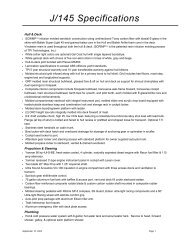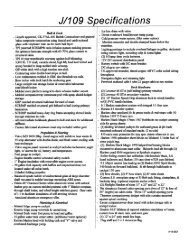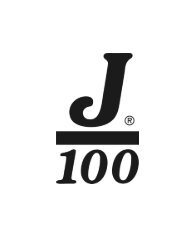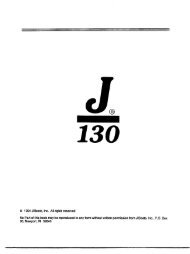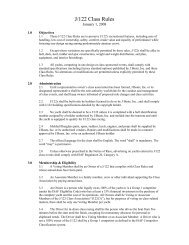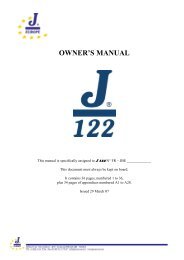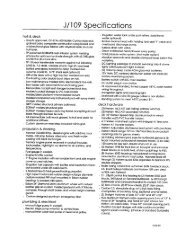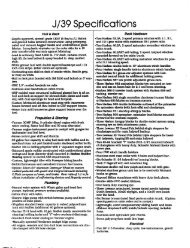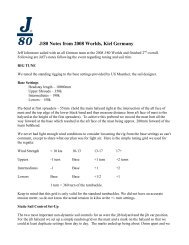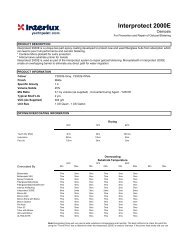J105 Owner Manual 2012.pdf - J/Owners
J105 Owner Manual 2012.pdf - J/Owners
J105 Owner Manual 2012.pdf - J/Owners
Create successful ePaper yourself
Turn your PDF publications into a flip-book with our unique Google optimized e-Paper software.
J/105 <strong>Owner</strong> Guide ...................................................................................................................................................................................................................................................... 30 <br />
Bleeding The Engine <br />
Reprinted from Mac Boring Service Bulletin: <br />
This bulletin contains helpful information for bleeding the fuel system of a Yanmar Diesel and <br />
other small diesels as well. Please post where your field service personnel can review. <br />
Since the presence of air in the fuel system anywhere between the fuel tank and the injector <br />
will lead to a no start or erratic running condition, always bleed the air from the system when <br />
the fuel system is disassembled, filter changed or if run out of fuel. <br />
1. Make sure fuel tank off is in "on" position. <br />
2. Bleed the air from fuel filter. Loosen the air bleed screw at the top of the fuel filter body <br />
and operate the manual handle the lift pump until the air bubbles completely expel in the <br />
fuel flowing from the filter. <br />
3. Bleed the air from the fuel return pipe. Loosen the connector bolt of the fuel return pipe <br />
installed on the fuel injector, and bleed the air by operating the manual handle of the lift <br />
pump. (If there is more than one injector, bleed the one at the end of the line). <br />
4. Bleeding the air from the fuel line -‐ (line from the filter to the injector pump). Loosen the <br />
air venting screw at the injection pump and operate the manual handle of the lift pump <br />
until all the air bubbles are out. <br />
5. Bleed the air from the fuel injector. Loosen the nipple on the fuel injector side, set the <br />
throttle to half and the decompression lever to the decompression position and crank <br />
engine. When no more bubbles appear in the fuel flowing from the end of the injection <br />
pipe, re-‐tighten the nipple. <br />
THIS BULLETIN IS FOR INFORMATION ONLY AND NOT AN AUTHORIZATION FOR REPAIRS <br />
Starting The Engine <br />
1. Turn the battery selector switch to ALL. Turn off all electronic instruments to avoid a <br />
voltage spike to the instruments while cranking the engine. <br />
2. Make sure that the throttle control is in neutral, or advanced neutral. <br />
3. Turn the ignition key to the ON position (if so equipped). The engine-‐alarm buzzer will <br />
sound and the warning lights for low oil pressure and charging will light up. (The alarm <br />
and warning lights will continue until the engine starts or the key is turned off.) <br />
4. If the engine-‐alarm is working correctly, continue to turn key. Release immediately when <br />
the engine starts. If the engine does not start in 10 seconds, turn off the key. Advance the <br />
throttle slightly (in neutral), wait 10 seconds, and repeat steps 3 and 4. <br />
5. When the engine starts, the oil-‐pressure and charging warning light will go out and the <br />
engine-‐alarm buzzer will stop. If they do not, stop the engine immediately.



